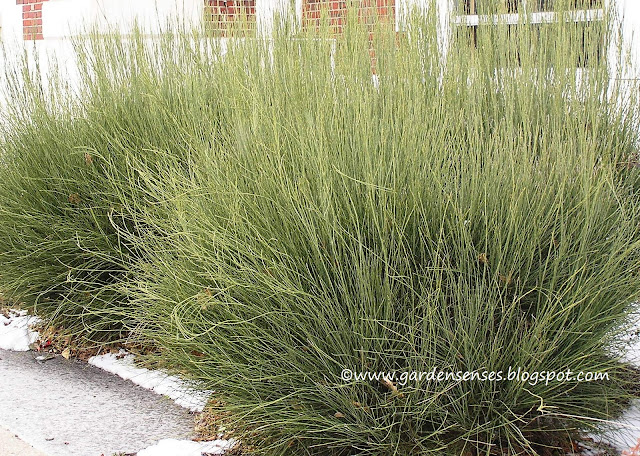Winter can be bleak in the garden. The boisterous summer and fall colors are long gone and things may be looking forlorn. That's why the "bones" of a garden are so important. "Bones" are elements that provide structure even in the winter (See Signature Gardens excellent post on "bones" here). As I was touring my neighborhood seeking out examples for this post, I saw a house looking decidedly bare, with no shrubs in sight. While summer may be a different story, there was nothing to cheer in the dead of winter. On the other hand, the house pictured above looks snug and welcoming with a generous and varied helping of evergreens.
While the winter garden can't compete with the lively summer show, you can have year round interest by including elements with a winter presence. Evergreen shrubs are an excellent part of the picture and there are many options that go beyond the yews of yesteryear.
Spreading Yew (Taxus repandens) is low growing with attractive arching branches, and won't grow out of bounds like other yews. It's unfortunate that their lovely form is sometimes pruned into sheared balls.
Mugo Pine (Pinus mugo) is a shrub with several dwarf cultivars (including 'Mops', 'Slowmound' and 'Paul's Dwarf') that grow to about 3' tall.
 Gold Mop False Cypress (Chamaecyparis pisifera 'Golden Mops') offers vibrant foliage with a feathery texture. This dwarf cultivar grows to about 3'.
Gold Mop False Cypress (Chamaecyparis pisifera 'Golden Mops') offers vibrant foliage with a feathery texture. This dwarf cultivar grows to about 3'.Dwarf Hinoki Cypress (Chamaecyparis obtusa 'Nana Gracilis') is a slow growing shrub with a pyramidal form for an upright element.
This large Golden Hinoki Cypress (perhaps Chamaecyparis obtusa 'Aurea' or 'Goldilocks' - 'Confucious' is a shorter variety) is a nice accent to Pieris japonica and Blue Spruce.
Scotch Broom (Cytisus x praecox) is looking bright and full in December, with a unique texture. This is a good example of the importance of botanical names - resources indicate that Cytisus x praecox is not invasive, while Cytisus scoparius is extremely invasive - read about it here.
This variegated Euonymus shrub (Euonymus fortunei cultivar) is a nice looking specimen -Euonymus shrubs generally don't have a uniform habit and can look unkempt.
This Cherry Laurel cultivar, perhaps 'Otto Luyken' (Prunus laurocerasus 'Otto Luyken'), has a nice scale- UConn Plant Data Base indicates a height of about 4 feet.
Thanks to Carolyn of Carolyn's Shade Gardens for the correction.
Japanese Holly (Ilex crenata) is a versatile broadleaf evergreen shrub with a nice uniform shape and a fine texture. There are a number of good cultivars including 'Green Luster' and 'Helleri'.
Inkberry (Ilex glabra) is another medium sized shrub with beautiful lustrous leaves, although it's leggy nature calls for some layering.
Ilex crenata 'Sky Pencil' is a fastigiate upright Japanese Holly cultivar.
Evergreen is a misnomer for these azaleas, which bring beautiful color to the winter landscape.
Pieris japonica is another bright spot of color. A number of cultivars, such as 'Mountain Fire,' have red new growth.
Prague Viburnum (Viburnum 'Pragense') seems to be more reliably evergreen in zone 6 than Leatherleaf Viburnum (Viburnum rhytidophyllum).
This is a beautiful specimen of Rhododendron (Rhododendron catawbiense) shining in the midwinter.
More evergreen shrubs which are featured in my Fall Fruit post (click here to see it) are: - Firethorn (Pyracantha)
- Heavenly Bamboo (Nandina)
- Hollies (Ilex x meserveae)
To see more foliage in Foliage Follow-up posts from around the world, visit Digging.
Evergreen shrubs will help give your garden structure to brighten those bleak winter months.












































